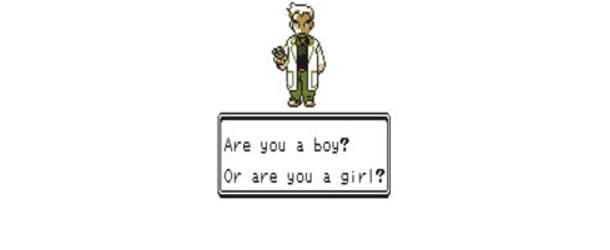 So, I’m gonna look at the words I used in my first article and define them, and some other terms that are important in transgender conversations.
So, I’m gonna look at the words I used in my first article and define them, and some other terms that are important in transgender conversations.
AFAB/DFAB: Assigned/Designated Female At Birth.
AMAB/DMAB: Assigned/Designated Male At Birth.
Binary: When used as an adjective, adhering to the gender binary. See “Gender Binary” below.
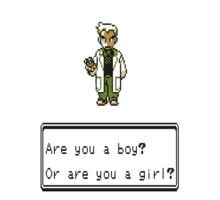 Professor Oak doesn’t understand nonbinary genders.
Professor Oak doesn’t understand nonbinary genders.
Cisgender: Identifying with the gender you were assigned at birth. Derived from the Latin prefix cis-, meaning “on this side of”. Most characters in videogames are cisgender.
Crossdressing: Wearing clothing that is generally associated with the opposite sex. Faris from Final Fantasy V crossdresses for much of her life in canon, but note that Faris only dresses as a man and does not personally identify as male. Naoto Shirogane from Persona 4 also crossdresses in canon, but I choose to see it differently—refer to them by neutral pronouns if you prefer the crossdressing interpretation while discussing them with me, please.
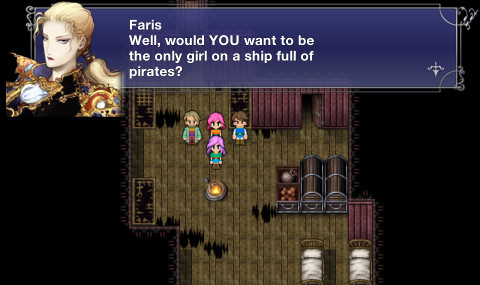 Faris has no time for sexist pirates.
Faris has no time for sexist pirates.
Gender Binary: The idea that only two possible gender identities exist. Most videogames assume this.
Gender Dysphoria: Experiencing significant discontent with the gender you were assigned at birth.
Hir: A gender-neutral oblique/possessive determiner/possessive pronoun. Designed to replace him/her. Pronoun of GameCola’s very own Robyn Tyrfing.
Intersex: A variation in sex characteristics which do not allow an individual to be distinctly identified/assigned as male or female. In videogames, intersex characters or characters lacking gender are most often of alien species, supernatural beings, or otherwise not human. As we can assume that most people playing videogames are probably human, this is likely tiring for players who identify as intersex.
 Quina Quen fits somewhere between the previous and following terms.
Quina Quen fits somewhere between the previous and following terms.
Nonbinary: Not fitting into the gender binary. GameCola’s very own Robyn Tyrfing does this! There’s a lot of nuance to this category, and different individuals may have differing reasons for using this term.
Transgender: Not identifying with the gender you were assigned at birth. Derived from the Latin prefix trans-, meaning “across from”. Does not get a lot of positive attention in videogames. Note that “transgender” is generally acceptable, while “transgendered” can be seen as a problematic term and should be avoided. Some agree, and some disagree, however I would err on caution and not use it.
Transition: Changing your gender presentation to accord with your internal sense of your gender. Dys4ia is a game about this.
Transman: An AFAB person transitioning to a male gender presentation. Naoto Shirogane of Persona 4 reads as a transman.
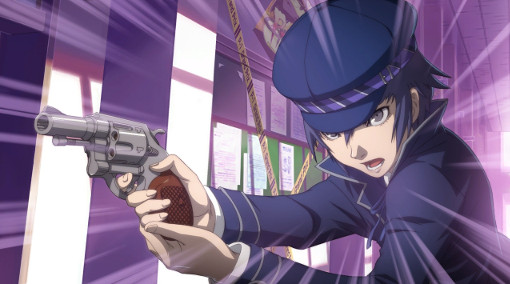 Naoto will shoot you if you don’t pay attention to preferred pronouns.
Naoto will shoot you if you don’t pay attention to preferred pronouns.
Transvestite: A person, usually cisgender and/or male, that derives sexual pleasure from dressing and presenting as the opposite gender.
Transwoman: An AMAB person transitioning to a female gender presentation. Birdo from the Super Mario franchise was originally designed as a transwoman, although these sentiments have largely been removed from American releases.
Xe: A gender-neutral nominative pronoun. Designed to replace he/she. Pronoun of GameCola’s very own Robyn Tyrfing.
My Trans Identity
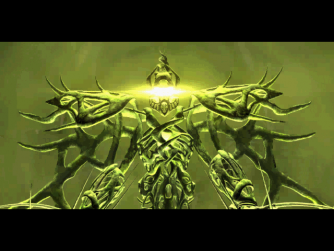 “I can forge planes with my gender, and I can unmake you!”
“I can forge planes with my gender, and I can unmake you!”
As a nonbinary/gender-neutral transgender person, I look at the “trans-” part as more “transcending” than “transitioning”. My identity allows me to explore expression and presentation however I like, with no need to fit an established social norm. After puberty, I had a desire to crossdress, but a transition wasn’t part of my identity at that point. I had no desire to take hormones, drastically alter my body, and run the possibility of health risks. But, after continuing dysphoria, a friend talked me into hormones because they’d help. Overall, I like myself a lot more now than before I started hormones.
You can see there aren’t people like me or with narratives even close to mine in videogames, and that makes the videogame industry feel hostile to me at times. Like I said in my first article, there are not a lot of positive binary transgender representation in videogames, and of course the more obscure presentations are even more misrepresented.
At the least, I hope this cleared up some confusion about the terms I used and my own personal identity. Wikipedia is a great source for further information, and so are many other websites, but reading on this subject is not for the faint of heart or for those who don’t have good attention spans.

So, how exactly do you pronounce your pronouns? Hir seems extremely problematic, as it could be pronounced exactly like “her”. And as for Xe, is the x pronounced like a z, or like a ks, or like kh (as in Russian), or like sh (like in Xion)?
I pronounce hir with a long I sound, similar to the word here but shorter. I pronounce xe with a Z and it rhymes with they, but pronouncing it with and kh rhyming with he is sounding pretty cool.
Hir isn’t a problematic pronoun for me. If it is for you, then I won’t refer to you as such, but I like it for my oblique /possessive determiner/possessive pronoun.
No, I’m definitely a him. I just thought that “hir” would be pronounced like “her”, making it difficult to tell if it’s hir or her. But since you pronounce it differently, it isn’t a problem.
It’s also a little problematic to consider another person’s pronouns as problematic. Even if it were pronounced like “her” that little “i” makes me feel more comfortable about myself, y’know?
I’m like 97% sure that Stefano is using “Problematic” to mean “Could be confusing”, not “Is personally objectionable” like it’s used when talking about social justice stuff.
Jeddy’s right. If I somehow offended you, I apologize.
I’m not offended, that comment was not about taking offense, I am trying to give you a sense of how important these little words are to us. It’s amazing how two letters can totally uplift or destroy a person.
This is extremely helpful, and I like how well you managed to keep this tied to videogames the whole time. This would’ve been an hour or two of research if I’d tried to sort this out all on my own.
I’ve plaed FF V (SNES version) before. When Faris revealed that she was a girl, I guess I didn’t think it was that much of a shocker because her sprite looks traditionally female here. Infact, in the GBA port you’ve included a screenshot of, her hair has her look even more traditional female.
And yet, the dialog sprite has her with blonde hair and a ponytail. I’m guessing the two artists didn’t really talk to each other, or is this some subtlety with video game art? I’ve seen in instruction booklets the “drawings” of many characters in that style in FF games, but they generally look pretty close to the in-game sprite.
I’m really new to this topic, but I gather that as time passes and the gen-pop becomes more familiar with these terms and facets, and perhaps some more standardization on the terms, that we may see more examples of these in main-stream media. It was not that long ago when video games only starred white guys and had a lot of ethnic stereotypes, but even that is still somewhat true.
That’s Yoshitaka Amano’s art style more than anything. He draws /really/ androgynous characters that err toward effeminate.
For sure. If you ever look at his official character artwork for a lot of the older Final Fantasy titles, the characters have very androgynous qualities, even if they are clearly male. I actually read somewhere that Amano was a huge inspiration with his character artworks, and could be why a lot of role-playing games today have lead male characters with effeminate qualities.
How true that is, I’m not sure, but I could definitely see that being true.
All character designs and artwork prior to Final Fantasy VII were the sole purview of Yoshitaka Amano, and he still provides promotional art and the occasional character design.